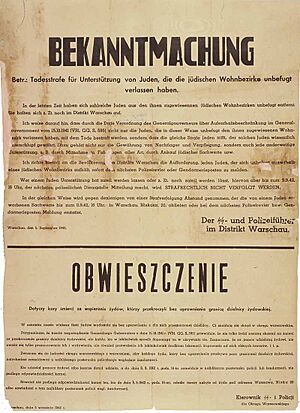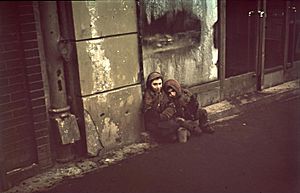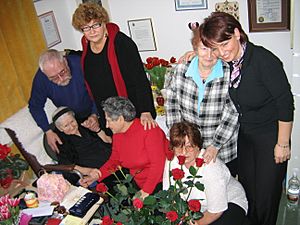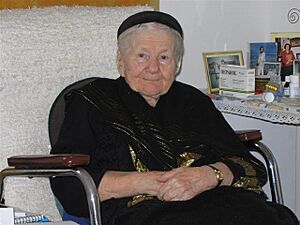Irena Sendler facts for kids
Quick facts for kids
Irena Sendler
|
|
|---|---|

Sendler c. 1942
|
|
| Born |
Irena Krzyżanowska
15 February 1910 Otwock, Poland
|
| Died | 12 May 2008 (aged 98) Warsaw, Poland
|
| Occupation | Social worker, humanitarian |
| Spouse(s) | Mieczyslaw Sendler (1931–1947; divorced) Stefan Zgrzembski (1947–1959; divorced; 3 children) Mieczyslaw Sendler (1960s; divorced) |
| Parent(s) | Stanisław Krzyżanowski Janina Krzyżanowska |
| Religion | Roman Catholic |
Irena Sendler was a brave Polish nurse and social worker. During World War II, she was part of the Polish Underground. She worked in Warsaw, which was occupied by Germany at the time.
Irena led the children's section of an organization called Żegota. This group helped Jewish people from 1942 to 1945. With the help of about 20 other Żegota members, Irena saved around 2,500 Jewish children. She smuggled them out of the Warsaw Ghetto.
These children were given false identity documents and safe places to hide. This saved them from the the Holocaust, a terrible time when many Jewish people were killed. Irena Sendler saved more Jewish people than almost anyone else during the Holocaust.
The German secret police, known as the Gestapo, found out about her work. They arrested her and sentenced her to death. But Irena managed to escape and survived the war.
In 1965, Israel honored her as one of the Righteous Among the Nations. This title is given to non-Jewish people who risked their lives to save Jews during the Holocaust. Later in her life, she received Poland's highest honor, the Order of the White Eagle. This was for her amazing efforts to help others during the war.
| Top - 0-9 A B C D E F G H I J K L M N O P Q R S T U V W X Y Z |
Irena Sendler's Early Life
Irena Krzyżanowska was born on February 15, 1910, in Warsaw, Poland. Her father, Stanisław Krzyżanowski, was a doctor. Her mother was Janina Krzyżanowska.
Irena grew up in Otwock, a town near Warsaw. There was a large Jewish community there. Her father was a kind doctor who treated poor people for free, including many Jewish patients.
Sadly, her father died in 1917 from a disease called typhus. He caught it from his patients. After his death, Jewish community leaders offered to help Irena's mother pay for her education. But her mother politely said no.
Irena studied Polish literature at Warsaw University. She joined the Polish Socialist Party. She protested against unfair rules at some universities before the war. These rules made Jewish students sit on special benches. Because of her protest, she was suspended from the university for three years.
Saving Children During World War II
Irena moved to Warsaw before World War II began in 1939. She worked for the city's Social Welfare department. She started helping Jewish people right after Germany invaded Poland.
She led a group of co-workers who made over 3,000 fake documents. These documents helped Jewish families. This work was very dangerous. From October 1941, helping Jewish people in German-occupied Poland meant death. Not just for the helper, but for their whole family. Poland was the only country where this strict rule was enforced.
In August 1943, Irena was given a secret code name: Jolanta. The underground organization Żegota chose her to lead its Jewish children's section. As a Social Welfare employee, she had a special pass. This allowed her to enter the Warsaw Ghetto. She pretended to check for typhus, a disease the Germans feared.
While inside the Ghetto, she wore a Star of David. This showed her support for the Jewish people. Irena and her team smuggled babies and small children out of the Ghetto. They used many clever ways. Sometimes they hid children in ambulances or trams. Other times, they used packages and suitcases.
The Jewish children were placed with Polish Christian families. Some went to orphanages or Catholic convents. Irena worked closely with about 30 volunteers, mostly women. These included Zofia Kossak-Szczucka and Matylda Getter.
The children were given fake Christian names. They were taught Christian prayers. This was in case they were tested by the Germans. Irena wanted the children to remember their true identities. So, she carefully wrote down their real names, their new names, and where they were hiding.
According to historian Debórah Dwork, Irena was the main person behind this rescue network. She inspired everyone. Irena herself directly smuggled out about 400 children. She and her co-workers buried lists of the children in jars. This helped them keep track of who was who and where they were. The goal was to return the children to their families after the war.
Arrest and Escape
In 1943, the Gestapo arrested Irena Sendler. As they searched her house, Irena quickly threw the lists of children to a friend. Her friend hid the lists in her clothes. If the Gestapo found these lists, all the children would be in danger.
Irena's friend was never searched. Irena refused to tell the Gestapo anything. She would not betray her friends or the children. She was sentenced to death by a firing squad.
But Żegota saved her life. They bribed the guards who were taking her to her execution. After her escape, she hid from the Germans. She returned to Warsaw using a fake name. She continued to help Żegota.
During the Warsaw Uprising, she worked as a nurse in a hospital. There, she hid five Jewish people. She kept working as a nurse until the Germans left Warsaw.
After the war, Irena and her team gathered all the children's records. They gave them to a colleague named Adolf Berman. He worked at the Central Committee of Polish Jews. Sadly, almost all of the children's parents had been killed. Most died at the Treblinka extermination camp or went missing.
Honors and Recognition
In 1965, Irena Sendler was recognized as one of the Polish Righteous among the Nations. A tree was planted in her honor in Israel. For many years, her brave actions were not widely known. This changed after the end of communist rule in Poland in 1989.
In 1991, Irena became an honorary citizen of Israel. She received the Commander's Cross of the Order of Polonia Restituta in 1996. In 2001, she received an even higher version of this award.
Irena Sendler's story became much more known in 1999. Students in Kansas, USA, with their teacher Norman Conard, created a play about her life. They called it Life in a Jar. The play was a big success. It was performed over 200 times in the US and other countries. This helped share Irena's story around the world.
In 2002, Irena and the students received an award for "saving the world." The play was also made into a TV movie in 2009. It was called The Courageous Heart of Irena Sendler. Actress Anna Paquin played Irena.
In 2003, Pope John Paul II sent Irena a personal letter. He praised her wartime efforts. On November 10, 2003, she received Poland's highest civilian award, the Order of the White Eagle.
In 2006, an award called "Irena Sendler's Award: For Repairing the World" was created. It honors teachers in Poland and America. Irena was nominated for the Nobel Peace Prize in 2007 and 2008.
On March 14, 2007, the Polish Senate honored Irena. A year later, the American Congress honored her. On April 11, 2007, she received the Order of the Smile. This award is given by children. She was the oldest person to receive it. She also became an honorary citizen of Warsaw and Tarczyn.
Irena said that the award from children was one of her favorites. She also cherished the Righteous among the Nations award and the letter from the Pope.
After her death, Irena received more honors. In April 2009, she was given the Humanitarian of the Year award. In May 2009, she received the Audrey Hepburn Humanitarian Award.
A documentary film about her, Irena Sendler, In the Name of Their Mothers, was released. It included her last interviews. The film won several awards.
In 2013, a walkway in front of the POLIN Museum of the History of Polish Jews in Warsaw was named after Irena Sendler. Memorial plaques honoring her were also placed in Warsaw. Several schools in Poland are named after her.
"Every child saved with my help is the justification of my existence on this Earth, and not a title to glory." (Irena Sendler)
Images for kids
-
Irena Sendler's tree on the Avenue of the Righteous at Yad Vashem in Israel
See also
 In Spanish: Irena Sendler para niños
In Spanish: Irena Sendler para niños
















